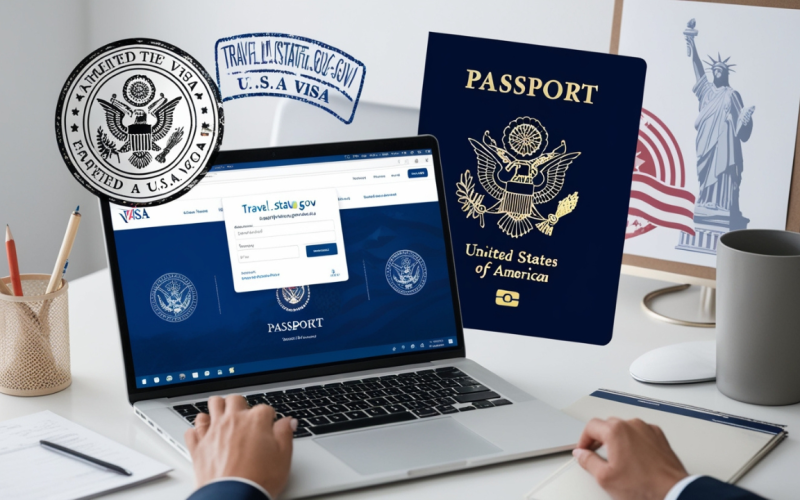Travel State gov Visa, If you plan to visit, work, study, or live in the United States, the first step is understanding the US visa application process. Travel.State.Gov, the official website of the US Department of State, provides comprehensive and reliable information for visa applicants. It covers everything from visa categories and application steps to wait times and embassies’ contact information. This guide will walk you through using Travel.State.Gov to make your visa application process clear and manageable.
The U.S. visa application process requires careful attention to detail, and understanding the purpose of each visa type will help you select the right one for your travel goals. This guide will provide insight into accessing accurate information on Travel.State.Gov, completing essential steps, and maximizing your chances for a successful visa application.
Key Takeaways
- Different visa types are available based on travel purposes, like tourism, work, or study.
- Travel.State.Gov is a reliable resource for all visa-related information.
- Preparing the correct documents before application saves time.
- Visa processing times can vary; checking them in advance is essential.
- Avoid misinformation by using official government resources.
Understanding US Visas
Differences Between Immigrant and Non-Immigrant Visas
U.S. visas are divided into two primary categories: immigrant and non-immigrant visas. An immigrant visa is intended for those who wish to live in the United States permanently, often due to family ties or employment. A non-immigrant visa, however, is designed for those who plan a temporary stay, such as for tourism, business, education, or medical purposes.
Understanding the difference between these categories is crucial, as the requirements and restrictions for each can vary widely. Travel.State.Gov provides detailed guidance on the eligibility, documentation, and specific processes associated with each visa type.
Common Visa Types and Their Purposes
Different visa types are available depending on an applicant’s purpose in the United States. For instance, a B-2 visa is suited for those traveling temporarily for tourism or medical treatment, while an F-1 visa applies to international students enrolled in U.S. institutions.
The H-1B visa is tailored for professionals in specialized fields who have been offered temporary employment in the U.S., and the J-1 visa accommodates individuals participating in cultural exchange programs. Selecting the correct visa based on your purpose of visit is essential for a smooth application process.
Eligibility Requirements for Each Visa Type
Eligibility criteria can vary significantly depending on the visa type. Travel.State.Gov provides comprehensive resources to understand these specific requirements, such as financial proof for a tourist visa or an employment offer for a work visa. Meeting these criteria is essential to a successful application, and missing or insufficient documentation often leads to delays or denials.
Using Travel.State.Gov for Visa Information
Key Resources on Travel.State.Gov
Travel.State.Gov is structured to guide users through each phase of the visa application. The Visas section provides an overview of available visa types, eligibility criteria, and necessary documentation. Another important section, US Embassies, offers contact details and location-specific requirements for US embassies and consulates worldwide.
The Visa Appointment Wait Times section provides timely information on how long it may take to schedule an interview or process a visa, helping applicants plan accordingly.
Navigating Visa Requirements on Travel.State.Gov
Applicants can navigate visa requirements by selecting their visa type on the Travel.State.Gov website. Each visa category page outlines necessary forms, application fees, and supporting documents. The website also includes step-by-step instructions for submitting documents and paying fees, along with guidelines on where to submit each item.
How to Track Your Visa Application Status
After submitting your application, you may wish to check on its progress. Travel.State.Gov offers a tracking tool, the Consular Electronic Application Center (CEAC), that allows applicants to monitor their visa status. This feature requires specific details from your application, such as your unique case number, which can be found in your application confirmation.
| Visa Type | Purpose | Example Uses |
|---|---|---|
| Immigrant Visa | Permanent residency | Family reunification, employment |
| Non-Immigrant Visa | Temporary stay for specific purposes | Tourism, study, work |
| Exchange Visitor | Educational and cultural exchange | Research, internship, Au Pair |
Using Travel.State.Gov for Visa Information
Travel.State.Gov is a user-friendly resource created to simplify the visa application process. The website has key sections dedicated to visa categories, embassy contacts, appointment wait times, and application requirements. By using this platform, you gain access to accurate, up-to-date information that is essential for completing a successful visa application.
Key Resources on Travel.State.Gov
The site has several useful sections, including Visas, U.S. Embassies, and Visa Appointment Wait Times. Each section offers information relevant to different stages of the visa process. Familiarizing yourself with these sections will save time and help ensure you complete each requirement accurately.
Visa Information: The Visas section offers an overview of available visa types, eligibility criteria, required forms, fees, and instructions for supporting documents. It also includes guides to common non-immigrant and immigrant visa categories.
U.S. Embassies and Consulates: This section lists contact details for U.S. embassies and consulates worldwide. Embassy-specific information, including local application requirements and processing details, can be found here.
Visa Appointment Wait Times: A frequently updated section that provides estimates on visa processing times, including timeframes for scheduling interviews and obtaining visa decisions.
Understanding and using these resources can help you avoid errors, reduce waiting periods, and stay informed about any policy updates that may impact your application.
Key Sections of Travel.State.Gov for Visa Applicants
| Section | Purpose |
|---|---|
| Visas | Overview of visa types, eligibility, and requirements |
| U.S. Embassies | Embassy contact info and local application details |
| Visa Appointment Wait Times | Current processing times for scheduling and issuance |
Steps to Apply for a US Visa
Applying for a U.S. visa involves several clear steps, and following each carefully can help prevent delays. Although the specific steps may vary depending on visa type and applicant’s home country, here’s an outline of the typical process:
Determine Your Visa Type
Your visa type is based on the purpose of your travel. Visit the visa section on Travel.State.Gov to identify the category that fits your needs. It’s essential to choose the correct type, as applying for the wrong one can result in a denied application or increased processing time.
Complete the DS-160 Form
Most non-immigrant visas require Form DS-160, an online application form that collects essential information about your background, travel intentions, and family details. Completing this form is a fundamental part of the process, and it requires accuracy. Be sure that all information aligns with your supporting documents, and remember to save and print the DS-160 confirmation page as you will need it for your interview.
Pay the Application Fee
Visa fees differ by category and can be paid through various methods depending on your location. The exact amount is specified on Travel.State.Gov, and payment is necessary to move forward in the process. Save the receipt, as you will present it during the interview.
Schedule an Interview
Most visa applicants between 14 and 79 must attend an interview at a U.S. Embassy or Consulate. Travel.State.Gov provides tools to schedule your interview, along with estimated wait times for appointments. Selecting an interview date early is recommended to avoid delays, especially during peak travel seasons.
Prepare for Your Visa Interview
Preparation is vital for a successful visa interview. Essential documents typically include your valid passport, the DS-160 confirmation, and any supporting financial or family records. During the interview, you may be asked about your travel purpose, background, and plans after your visit to the U.S.
Required Documents for Visa Interviews
| Document | Purpose |
|---|---|
| Passport | Identity verification |
| DS-160 Confirmation | Proof of online application completion |
| Visa Fee Payment Receipt | Evidence of paid application fee |
| Financial Evidence | Proof of funds to support U.S. stay |
Important Tips for a Successful Visa Process
Completing the visa application process can be complicated, and attention to detail is essential. Here are some tips to enhance your chances of success:
Double-Check Your Documentation
Inaccurate or incomplete documentation is a common reason for visa denials. Ensure all forms, including DS-160, contain accurate information, and review each field before submission. Keep physical and digital copies of all documents, including receipts and confirmations, for easy access.
Plan Around Visa Processing Times
Visa processing times vary significantly based on location, season, and visa category. Travel.State.Gov provides up-to-date estimates that help you plan your application timeline. Planning ahead and accounting for possible delays, especially around holiday seasons, is crucial for meeting travel deadlines.
Stay Updated on Visa Policies
Visa policies are subject to change, particularly with global travel fluctuations. Regularly checking Travel.State.Gov ensures you stay informed about any updates that might impact your application process, such as new eligibility criteria or updated fee structures.
Frequently Asked Questions (FAQs)
How do I know which visa type I should apply for?
Travel.State.Gov provides a guide to help determine the correct visa based on your travel purpose. Generally, non-immigrant visas are for short-term stays, while immigrant visas are for permanent residency.
Is a visa interview required for all applicants?
Most applicants aged 14-79 must attend an interview. Some individuals, such as children or seniors, may qualify for interview waivers.
What happens if my visa application is denied?
If your application is denied, you may reapply, but it’s important to address the reasons for the denial. Common reasons include incomplete documents or lack of financial support.
How long does it take to receive my visa after the interview?
Processing times vary based on location and visa type. Generally, visas are issued within a few days to several weeks. Check Travel.State.Gov for specific wait times.
Is there an option to expedite my visa application for urgent travel?
Expedited processing is available for certain visa types and urgent situations. Check with your local U.S. Embassy for eligibility and application procedures.
Steps to Apply for a US Visa
Determine Your Visa Type
The type of visa you need will depend on the purpose of your trip. Travel.State.Gov provides resources to help you choose the appropriate visa category, which is an essential first step to ensure you meet all requirements and avoid issues in processing.
Complete the DS-160 Form
For most non-immigrant visas, applicants must complete the DS-160 form. This form collects information on personal background, travel purpose, and family details, and it is important to fill out the form accurately. Mistakes can delay the process, so double-check all information before submission. Once completed, save and print the DS-160 confirmation page, as it will be required during the interview.
Pay the Application Fee
Each visa type has a specific application fee that must be paid before moving forward. Travel.State.Gov lists the fee structure for each visa type, and payment methods vary depending on your location. Retaining proof of payment is necessary, as this receipt will be needed for the interview.
Schedule an Interview
Most applicants aged 14-79 are required to attend a visa interview. Travel.State.Gov offers tools to schedule an interview at a U.S. Embassy or Consulate near you. It is advisable to schedule the interview as early as possible, as wait times can vary based on location and season.
Prepare for Your Visa Interview
Preparing for the interview is a critical part of the application process. Essential documents typically include your valid passport, the DS-160 confirmation page, the visa fee payment receipt, and any supporting documents such as proof of financial stability or family ties. During the interview, a consular officer will assess your eligibility based on your answers and documentation.
What to Expect During the Visa Interview Process
Preparing for Common Interview Questions
Visa interviews are a routine part of the application process, especially for those seeking non-immigrant visas. During the interview, applicants may be asked about their travel plans, financial capacity to cover expenses, family ties, or intentions to return to their home country. These questions help the consular officer evaluate the applicant’s eligibility for a visa and verify that they meet the necessary requirements.
Documents to Bring to Your Interview
Bringing the correct documentation to the interview is crucial for a successful application. Required documents generally include a valid passport, DS-160 confirmation page, visa fee payment receipt, and any specific supporting documents that confirm your purpose of visit or eligibility for the visa category. Ensuring all documents are up to date and accurately filled out reduces the risk of delays or denials.
What to Expect at the U.S. Embassy or Consulate
The interview process typically takes place at a U.S. embassy or consulate. Security screenings are standard, so arriving early can help you complete these steps in time. Once inside, applicants will meet with a consular officer who will review their documents and conduct the interview. Following the interview, the officer will inform the applicant whether their visa has been approved or if additional processing is required.
Tips for a Successful Visa Application
Avoiding Common Application Errors
Errors in documentation or application forms are common reasons for visa denials. Checking all information carefully before submission and ensuring documents are accurate and complete can help prevent delays. Even minor mistakes, such as mismatched dates or misspelled names, can impact your application.
Planning Around Visa Processing Times
Visa processing times vary depending on the type of visa, season, and location. Travel.State.Gov offers a section that provides current estimates for processing times, which can help you plan accordingly. It is essential to factor in these wait times when planning your trip to avoid any disruptions in travel plans.
Double-Checking Documentation for Accuracy
Documentation errors can be costly and lead to denied applications. Double-checking each form and document for accuracy, including names, dates, and other personal information, is a valuable step in ensuring a smooth application process.
Handling Visa Challenges and Denials
Common Reasons for Visa Denials and How to Avoid Them
Visa denials may occur due to missing documents, insufficient proof of financial means, or inconsistencies in the application. Travel.State.Gov provides guidelines on common reasons for denial, helping applicants understand and avoid these pitfalls. Following each requirement carefully and providing all necessary supporting evidence strengthens an application and reduces the likelihood of rejection.
Steps to Take if Your Visa Application is Denied
If your visa application is denied, it’s essential to understand why. Often, applicants can reapply after addressing the reasons for denial, such as updating documentation or providing additional proof of eligibility. Checking Travel.State.Gov for reapplication procedures can help applicants prepare more effectively.
Reapplying for a Visa After a Denial
Reapplying for a visa may be possible, but addressing the reasons for the initial denial is essential. Travel.State.Gov provides resources for applicants who wish to reapply, with guidance on updating documents or meeting additional requirements to strengthen the new application.
Special Considerations for First-Time Visa Applicants
Key Differences for First-Time vs. Returning Applicants
First-time visa applicants may need to provide more extensive documentation, as they lack a prior U.S. travel history. Travel.State.Gov offers resources that clarify these additional requirements, which can include more in-depth background checks or evidence of strong ties to the applicant’s home country.
Understanding Required Documents for First-Time Applicants
First-time applicants may be asked to submit additional documents to prove their purpose of visit, financial stability, or personal ties. Ensuring these documents are complete and aligned with the requirements for the specific visa type is essential for a smoother process.
Additional Important Information
How Long You Can Stay on a Non-Immigrant Visa
The maximum duration of stay varies for each non-immigrant visa type. For instance, tourist visas generally allow stays of up to six months, while student visas may permit longer stays depending on the academic program’s duration. Adhering to the visa’s permitted duration and avoiding overstaying helps maintain a good standing with U.S. immigration authorities.
Renewing or Extending Your Visa
Renewing or extending a visa is an option for some non-immigrant categories, such as student or work visas. Travel.State.Gov provides detailed instructions for those seeking a renewal or extension, outlining the application process, required documents
My Opinion
The U.S. visa application process may seem complex, but using Travel.State.Gov as your primary resource makes it more manageable. From understanding visa categories to checking wait times, the site offers clear guidance on each application stage. Ensuring you have all required documents, completing forms accurately, and preparing for the visa interview will increase your chances of a successful outcome. By staying informed and organized, you can navigate the visa process with confidence and prepare for your journey to the United States.







